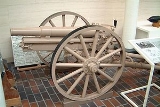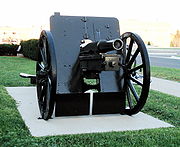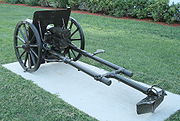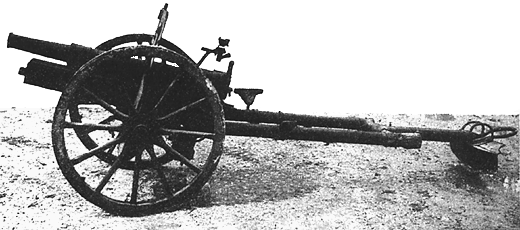
Type 41 75 mm Mountain Gun
Encyclopedia
The Type 41 75 mm mountain gun is a Japanese license-built copy of the Krupp M.08 mountain gun
. Originally it was the standard pack artillery weapon. After it was superseded by the Type 94 75 mm mountain gun
, it was then used as an infantry "regimental" gun, deployed 4 to each infantry regiment, and referred to as "Rentai Ho" (regimental artillery). Two gun shields were produced for the weapon, an early type, which folded into thirds, and a late type, which folded in half.
In Japanese service the gun was crewed by thirteen men, twelve gunners and a squad leader. When the weapon was being fired there would be one aimer, one loader, one firer, one person to swing the guns aim left or right, a man inserting the fuzes into rounds and handing them to the loader, two gunners lying in reserve to the left and right of the gun position, and the squad leader sitting a little distance to the rear of the weapon. The remaining five men would ferry ammunition in relays from the ammunition squad, which would typically be in cover a few hundred meters behind the gun's position.
The weapon could be transported complete by its thirteen man squad, or broken down into parts and carried on six pack horses using special harnesses, a seventh horse was used to carry ammunition.
Two types of impact fuze were available for the Type 97 75 mm High Explosive round, one with a delay of 0.05 seconds, the second with a delay of 1 second. U.S. Army testing of the weapon at a range of 3,200 yards resulted in 75 percent of the rounds falling in a rectangle 20 by 30 yards. At maximum range (7,800 yards) 75 percent of the rounds fell within a rectangle 10 yards wide and 200 yards long.



Mountain gun
Mountain guns are artillery pieces designed for use in mountain warfare and areas where usual wheeled transport is not possible. They are similar to infantry support guns, and are generally capable of being broken down into smaller loads .Due to their ability to be broken down into smaller...
. Originally it was the standard pack artillery weapon. After it was superseded by the Type 94 75 mm mountain gun
Type 94 75 mm Mountain Gun
The was a mountain gun used as a general purpose infantry support gun by the Imperial Japanese Army during the Second Sino-Japanese War and World War II. It superseded the Type 41 75 mm Mountain Gun to become the standard pack artillery piece of Japanese infantry divisions...
, it was then used as an infantry "regimental" gun, deployed 4 to each infantry regiment, and referred to as "Rentai Ho" (regimental artillery). Two gun shields were produced for the weapon, an early type, which folded into thirds, and a late type, which folded in half.
In Japanese service the gun was crewed by thirteen men, twelve gunners and a squad leader. When the weapon was being fired there would be one aimer, one loader, one firer, one person to swing the guns aim left or right, a man inserting the fuzes into rounds and handing them to the loader, two gunners lying in reserve to the left and right of the gun position, and the squad leader sitting a little distance to the rear of the weapon. The remaining five men would ferry ammunition in relays from the ammunition squad, which would typically be in cover a few hundred meters behind the gun's position.
The weapon could be transported complete by its thirteen man squad, or broken down into parts and carried on six pack horses using special harnesses, a seventh horse was used to carry ammunition.
Two types of impact fuze were available for the Type 97 75 mm High Explosive round, one with a delay of 0.05 seconds, the second with a delay of 1 second. U.S. Army testing of the weapon at a range of 3,200 yards resulted in 75 percent of the rounds falling in a rectangle 20 by 30 yards. At maximum range (7,800 yards) 75 percent of the rounds fell within a rectangle 10 yards wide and 200 yards long.



Ammunition
- Type 98 High-explosive - 9.9 lb
- Type 97 High-explosive - 12.1 lb
- Type 94 High-explosive - 13.24 lb
- Type 90 High-explosive - 12.50 lb
- Type 95 Armor piercing high-explosive - can penetrate 20 mm of steel plate at 3,000 m - 13.66 lb
- Type 1 Armor-piercing - 14.4 lb
- Type 38 Shrapnel - 15.0 lb
- Type 90 Shrapnel - 282 10.5 gram lead balls and 0.1 kg black powder bursting charge - 15.4 lb
- Type 2 Hollow charge - 7.81 lb (3 inches of RHA)
- Incendiary
- Type 90 Smoke (white phosphorus) - 12.60 lb
- Type 90 Incendiary - 15.3 lb
- Liquid incendiary projectile - 11.75 lb
- Type 90 Illuminating - 12.44 lb
- Vomit gas projectile - 13.25 lb

